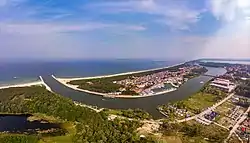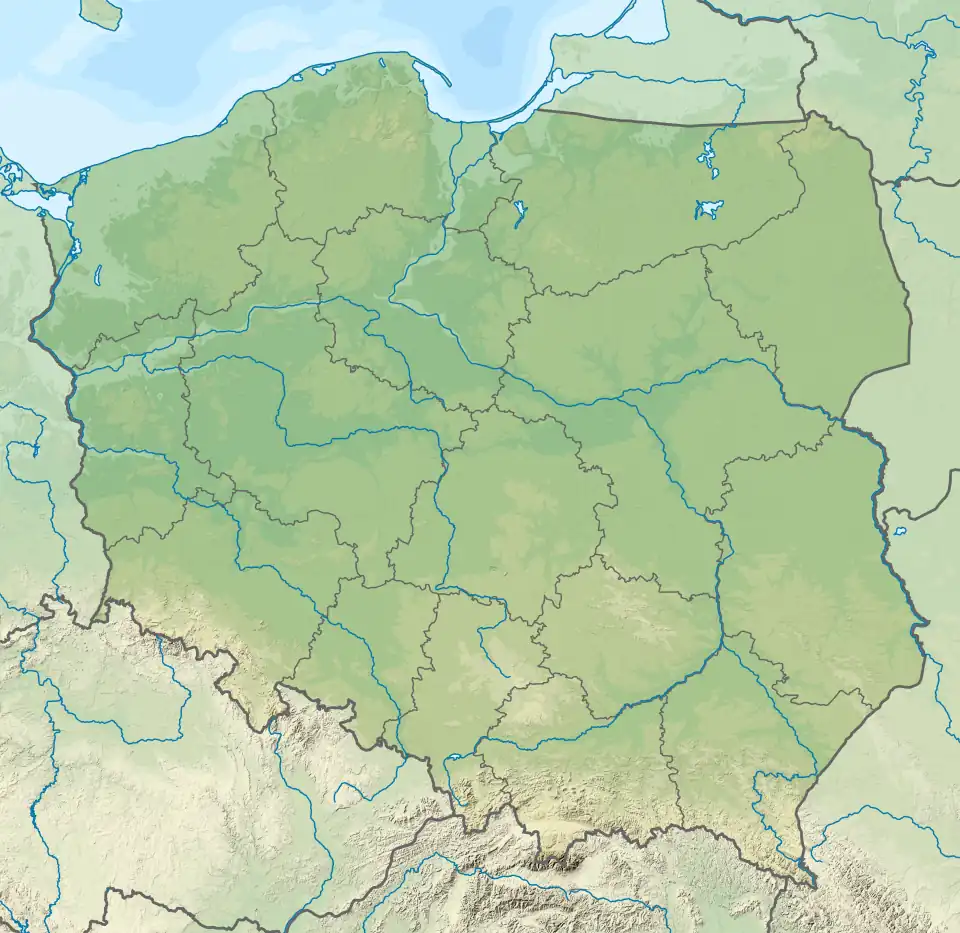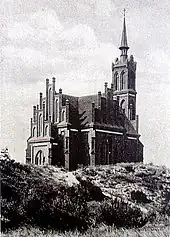Dziwnów
Dziwnów [ˈd͡ʑivnuf] is a town in north-western Poland situated on the Baltic Sea at the mouth of the river Dziwna which divides it into the right-bank part containing the center of the town, belonging to historical Farther Pomerania, while the left-bank part is located in Western Pomerania, with both parts connected through a bascule bridge. It is a part and the seat of the eponymous Dziwnów municipality within Kamień County, West Pomeranian Voivodeship. As of December 2021, the town has a population of 2,595.[1]
Dziwnów | |
|---|---|
 Aerial view of Dziwnów along the Baltic Sea | |
 Flag  Coat of arms | |
 Dziwnów  Dziwnów | |
| Coordinates: 54°1′N 14°45′E | |
| Country | |
| Voivodeship | |
| County | Kamień |
| Gmina | Dziwnów |
| First mentioned | 1243 |
| Town rights | 2004 |
| Government | |
| • Mayor | Grzegorz Jóźwiak |
| Area | |
| • Total | 4.93 km2 (1.90 sq mi) |
| Population (31 December 2021[1]) | |
| • Total | 2,595 |
| • Density | 530/km2 (1,400/sq mi) |
| Time zone | UTC+1 (CET) |
| • Summer (DST) | UTC+2 (CEST) |
| Postal code | 72-420 |
| Area code | +48 91 |
| Car plates | ZKA |
| Voivodeship roads | |
| Website | https://www.dziwnow.pl |
History

The territory became part of the emerging Polish state under its first ruler Mieszko I around 967.[2] The battle at Julin Bridge took place nearby in 1170, but the oldest known mention of the village dates back to 1243.[3] It remained a small fishing village until the 19th century, when it began to transform into a holiday resort.[3] At the end of the 19th century, salt springs were discovered, and the first sanatorium was established.[3] In the 1930s, military barracks were built.[3] During World War II, in June 1944, Americans conducted air raids on the German garrison in the village.[3] The historic church was destroyed in the final stages of the war. At the end of World War II, Polish troops entered the village in May 1945.[3]
In 1949 and 1950 in the local garrison there was a military hospital for Greeks and Macedonians wounded in the Greek Civil War.[3][4] In total, around 2,000 people were treated there.[4] Later on, in the 1950s, the hospital staff co-created the Military Medical Academy in Łódź.[3] In 1958 Dziwnów was granted urban-type settlement status and afterwards a port was built.[3] The development of the settlement in the following decades led to the granting of municipal rights in 2004.[3] From 1964 to 1986, the 1st Assault Battalion, which was considered one of the best trained units in the history of the Polish Army, was stationed in Dziwnów.[5]
International relations
 Gorzów Wielkopolski, Poland (2014)
Gorzów Wielkopolski, Poland (2014) Sosnowiec, Poland (2013)
Sosnowiec, Poland (2013) Werneuchen, Germany (1993)
Werneuchen, Germany (1993)
Gallery
 Fishing Port
Fishing Port Yacht Quay
Yacht Quay Bascule bridge
Bascule bridge.JPG.webp) Beach
Beach
References
- "Local Data Bank". Statistics Poland. Retrieved 2022-08-02. Data for territorial unit 3207014.
- Labuda, Gerard (1993). "Chrystianizacja Pomorza (X–XIII stulecie)". Studia Gdańskie (in Polish). Vol. IX. Gdańsk-Oliwa. p. 47.
- "Historia Dziwnowa". dziwnów.pl (in Polish). Retrieved 26 November 2019.
- Kubasiewicz, Izabela (2013). "Emigranci z Grecji w Polsce Ludowej. Wybrane aspekty z życia mniejszości". In Dworaczek, Kamil; Kamiński, Łukasz (eds.). Letnia Szkoła Historii Najnowszej 2012. Referaty (in Polish). Warszawa: IPN. pp. 116–117.
- "1 Batalion Szturmowy". dziwnów.pl (in Polish). Retrieved 26 November 2019.
- "Miasta Partnerskie". dziwnow.pl (in Polish). Gmina Dziwnów. Retrieved 2022-08-02.
